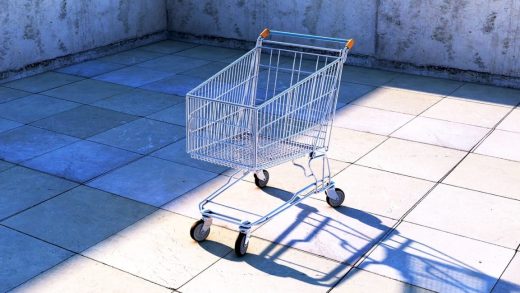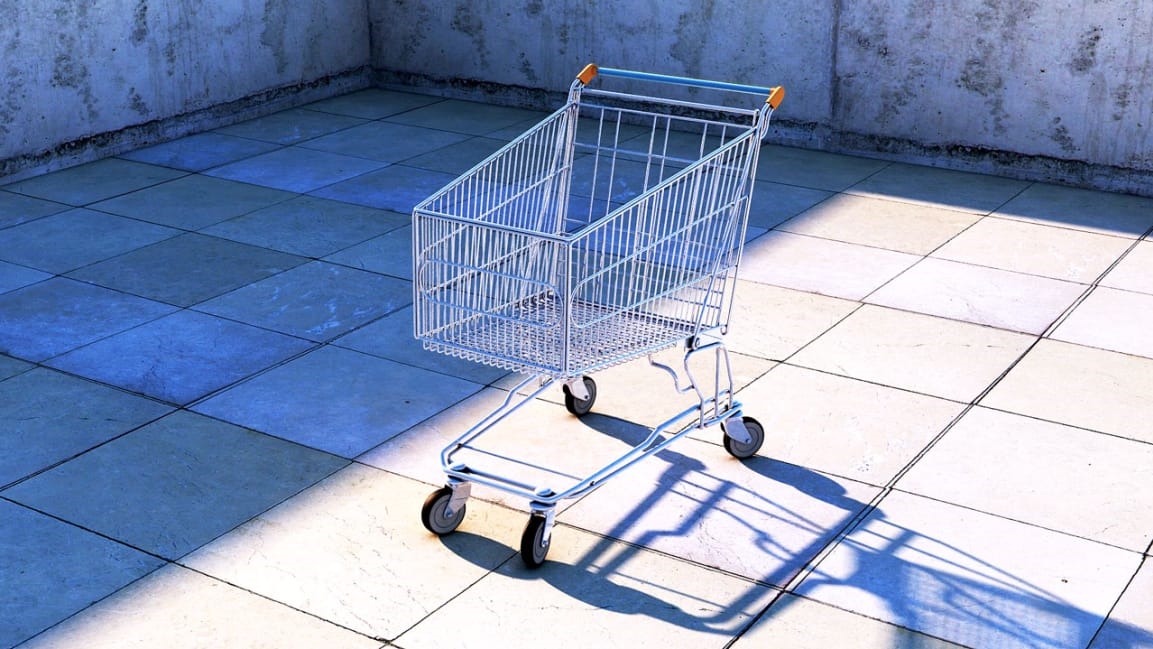New documents challenge Instacart’s claim that workers get 100% of tips
Grocery-delivery service Instacart has had an increasingly contentious relationship with its drivers in recent months, beginning with changes to its payment algorithm in November that some workers say have resulted in lower compensation. But the most explosive issue is a claim that the company is not honoring its well-advertised pledge to give 100% of customers’ tips to drivers.
Instead, say drivers, Instacart factors the expected tip amount into the calculation of the fee it provides, called the “batch incentive,” so that drivers get as many jobs paying a minimal $10 fee as possible. In short, some drivers claim, Instacart lowers the batch payment, which comes out of its own pocket, when customers tip more–keeping overall compensation lower than if 100% of the tip really went to the driver.
Instacart counters with the exact opposite, asserting that it raises the batch payment when customers tip less, to ensure that drivers earn at least $10 on every job.
It’s difficult to prove or refute either claim, due to all the variables in calculating the batch payment for each order under a new algorithm, rolled out nationally in November after months of consultation with Instacart’s contract delivery workers, known as shoppers.
Variables in the new payment calculation include the number of products, the weight of each product, and even the store they come from. Instacart also adds a separate fee based on mileage, plus occasional extras like a “quality bonus” for a 5-star customer review. Another wrinkle: some gigs require the contractors to shop for and deliver the orders, while others require only delivering orders packed by in-store Instacart employees.
Drivers have shown receipts to Fast Company that compare roughly similar orders, but until now they haven’t demonstrated identical jobs in which only the tip amount—and consequently the batch payment—differed.
Until last week, when in a national Facebook group for Instacart drivers, a driver posted receipts for two identical jobs to the same customer on two different days–each containing the same bottle of vodka and bag of ice, requiring the same travel of 3.3 miles. The first order, in which the customer had specified a $2 tip, provided a “batch payment” (batch incentive plus mileage) from Instacart of $8. On the second, for which the tip was $6, Instacart’s batch payment dropped to $4.
Matthew Telles, another Instacart driver, and a vocal critic, then posted these receipts to Twitter.
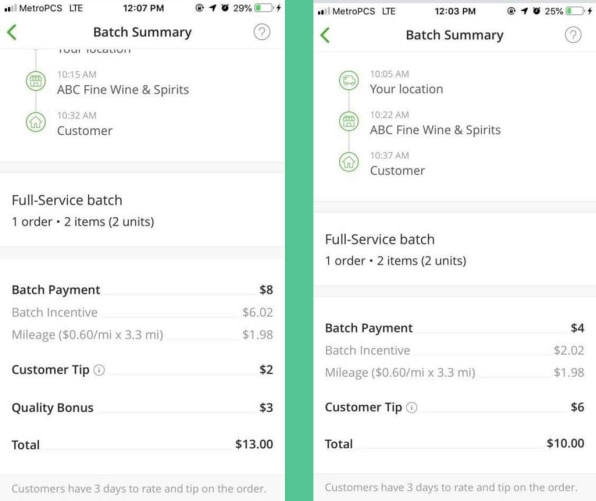
The Smoking Gun?
To disgruntled drivers, these receipts represent the smoking gun, showing that higher tips make up for low batch payments. To Instacart, it’s proof that higher batch payments make up for low tips. (This is simply the clearest of multiple examples drivers sent us.)
But Instacart is sending mixed messages about how its payment system works. “The batch incentive is set independent of the tip on that order and it is never lowered based on a tip that is received on that order,” Instacart’s dual CFO & COO Ravi Gupta tells Fast Company, describing how the system works for any order. Perhaps it isn’t lowered based on the tip, but Instacart seems to concede that it may be raised, in which case the batch incentive is not set independent of the tip.
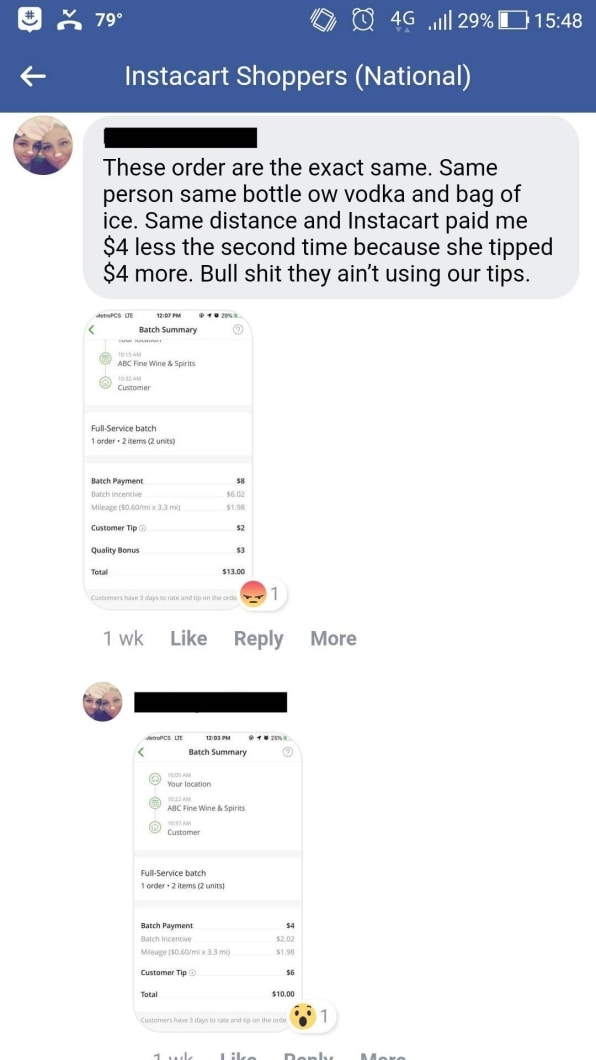
One question raised by these examples: If Instacart would like drivers to make at least $10 per job, why does its algorithm often produce such lower batch payments? That’s an especially pertinent question for drivers who claim that payments from Instacart have declined for similar jobs since November–as much as 30%. (Instacart says that payments have remained the same on average.)
The higher-tip case shows that spending a half hour delivering groceries is worth no more than $4, according to Instacart’s algorithm. And shoppers have flagged more extreme examples, like paying $2.97 for a 37-product order that took 96 minutes to shop and deliver.
“The reason why tips exist, it seems, is to give workers extra,” says Sage Wilson, communications director for labor rights organization Working Washington. It’s leading a campaign, asking Instacart customers to tip just 22 cents on all orders–thus forcing Instacart to pay more in batch payments.
By default, Instacart’s customer app includes a tip of 5% of the total value of the goods ordered. Customers can change the tip amount any time from before placing the order to three days after delivery. So those initially tipping 22 cents could increase the tip after the workers have already been awarded the higher batch payment. “The amount that a customer is tipping does not lower our batch incentive,” confirms Instacart’s chief product officer, David Hahn.
The petition accompanying the protest has gathered signatures from about 1,600 Instacart workers. Though generally focused on Washington State issues, the organization’s petition has drawn signatures from across the country. Now Working Washington has announced a national online organizing meeting of Instacart contractors on February 13.
80-cent example prompts $3 minimum wage
The identical jobs example comes on the heels of an embarrassing case, publicized by Working Washington, in which a driver received just an 80-cent payment from Instacart. The tip was $10. And the driver, who asked that Fast Company identify him only as Tom, alleges that 80 cents was simply the minimum amount that Instacart’s algorithm was able to generate. (It breaks down to 42 cents for travel of 0.7 miles and 38 cents in batch incentive.)
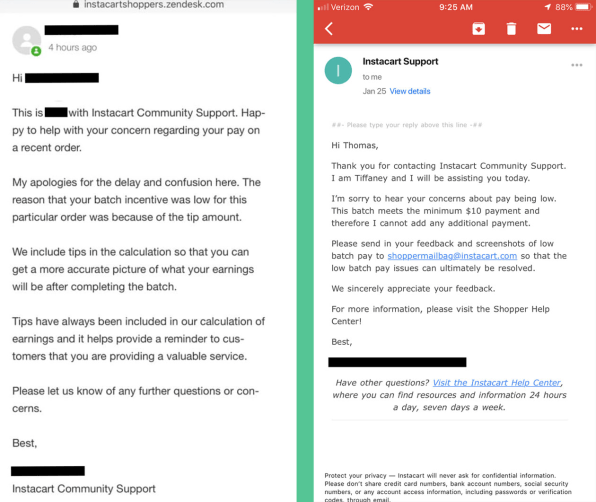
In response to Tom’s case, Instacart just announced that it will guarantee a $3 minimum batch payment on all jobs, irrespective of tip or what the algorithm generates. It calls Tom’s 80-cent payment a “one in 100,000 edge case”–basically a technical glitch, for which the new $3 minimum is a fail-safe. But Tom and other disgruntled drivers see it as something different: proof that Instacart is pilfering tips in order to pay as little as possible.
Tom has presented multiple messages from Instacart support workers that seem to verify this interpretation. “The reason that your batch incentive was low for this particular order was because of the tip amount,” wrote an Instacart Community support representative in an email to Tom.
“The information we provided was not accurate,” says Gupta, asserting that the representative misspoke to Tom. “We have to invest and continue to invest in better training and tools so that we get it right every time.”
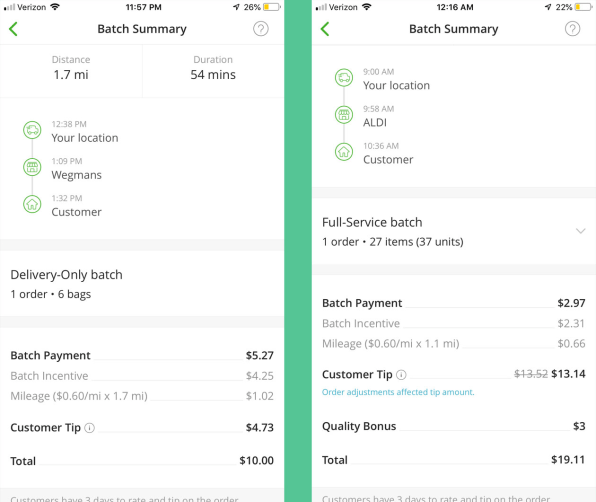
If so, then Instacart got it wrong twice in Tom’s case. He presented Fast Company with a second message, from a second support staffer stating, “I’m sorry to hear your concerns about pay being low. This batch meets the minimum $10 payment and therefore I cannot add any additional payment.”
Tom, meanwhile, has sent several examples to Fast Company of jobs that–between tip and batch payment–all come out to precisely $10. They would have paid more, he says, before Instacart’s new payment system was introduced.
“There are a lot of larger jobs with pretty absurdly low batch incentives,” says Wilson.
(15)

